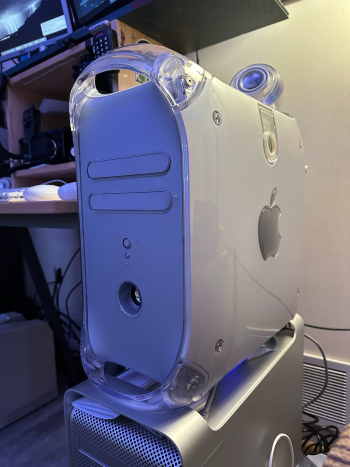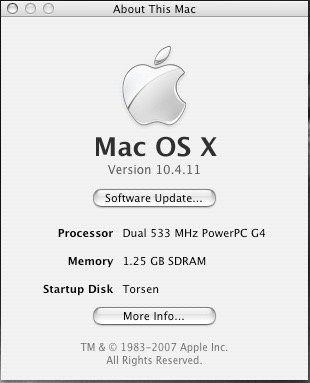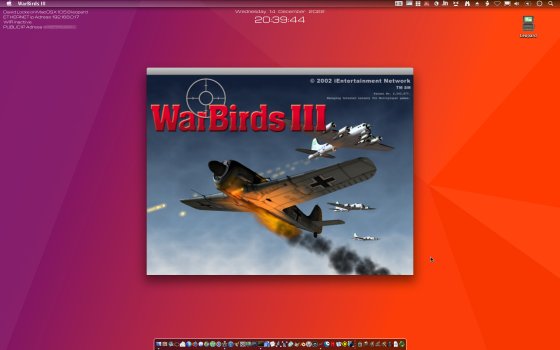Over this weekend, I wrapped up doing the same passive cooling modification work on my A1139 PowerBook G4, much as I did previously with my 15-inch
A1138 PowerBook G4 (above) and on my 17-inch
A1261 MacBook Pro.
A full write-up will be posted when I get to it. What I can share is the heat sink assembly design is closer to the A1261 than the A1138. Unlike the A1261, I also threw down some thermal pads in the dual fan cooling areas and, unlike either of the previous two, also applied a bit of thermal paste at the point where the heat sink, by OEM design, makes contact with the bottom case. In other words, I pushed the passive cooling as far as I could.
Provisional results: whilst running Macports 10.5.8 compiles (
port upgrade outdated, over a month since last
port selfupdate ), in a 23–24°C room (with G4FanControl set to 48:48:48, identical to the A1138), I haven’t been able to push the CPU beyond 52°C or the Intrepid beyond 46°C, despite the CPU holding at a steady 100% as Macports runs. The highest I can manage to get a fan to move is about 5250rpm (left fan) — well short of its 6204rpm max design capacity (the right fan is loping along at a leisurely 2500rpm).
More soon.
 EDIT:
EDIT: Screen cap added
View attachment 2123503
EDIT to add: Heck, I think I’m so impressed by what I’m seeing here that I’m seriously flirting with the idea of opening the A1261 once more and doing to it what I did on the A1139 — namely, adding thermal pads to the pair of fan fins and also adding thermal paste to the contact points between heatsink assembly and bottom case. The nice thing about doing this with the A1261 is I can access temperature histories and compare them more readily.
The bigger write-up I had hoped to post soon after the above was beset by other life stuff.
So here’s a little more to that passive cooling mod on the A1139 17-inch PowerBook G4 (the DLSD model).
BACKGROUND
Although overall heating issues I’d been facing with my similar form-factor A1261 (the early 2008 17-inch MacBook Pro) were never as extreme with the A1139 PowerBook G4 — that, is, the PowerBook never came close to scalding my thighs — it could still get warm enough, under load, to send its fans to their full-speed limits.
This hadn’t really been too much of an issue during the first, say, 18 months
after I bought it. One of the first things I did after finding the laptop in 2019 was to
clean out the OEM paste and pad with Noctua NT-H2.
Then, in 2021, I started dealing with extremely noisy fans — which sometimes would stop spinning noisily after I batted the top case, above the fan, with my hand; other times, they’d simply get louder and slow down to absurdly low speeds (like 250rpm whilst sounding like a cacophony of inefficiency).
Hitting electronics, of course, is never really a long-term remedy and is, in the long term, liable to cause new, unwanted problems. I tended to the fans, eventually, using
one type of lubricant which worked for, maybe, nine months (after initially trying out powdered graphite). High fan speeds on the A1139 were common even when the system was idling, so eliminating the noise was a basic necessity.
Nevertheless, the PowerBook still needed intervention from the fans — noisy or not — prior to trying out the passive cooling of adding thermal pads beneath the heat pipes, to enable them to make direct contact with the aluminium of the bottom case, and to use the case for heat dissipation first before letting the fans move out the remaining, excess heat.
As with when I added thermal pads to the A1138 PowerBook last month, I rushed into it and forgot to screen cap the temp readings, but they’d been, more or less, the same for many months:
CPU Bottom and
CPU/Intrepid Bottom typically floated around 48–49°C, and both fans, design to run as high as 7000rpm, ran typically in the low to moderate range (~2300–4000rpm, depending on room conditions). In a cool room, I
might see one of the sensors fall to 47°C, with one fan shut off.
G4FanControl on the A1139, just like the A1138, is set at 48:48:48.
ADDING THERMAL PADS (AND PASTE)
Unlike the 15-inch A1138, whose heat sink pipe assembly is about 3.5–4.0mm above the bottom case and surrounded by a plate of holes, the design of the A1139 heat sink pipe assembly is much closer, seen below nearly edge-on — just as it is with the A1261 17-inch MacBook Pro and whose plate has no holes:

(Note: in the above, the side facing
up is the side which, when the system is running, faces
down toward inside of the bottom case.)
So the thermal pad application approach would be a lot
like the method I used for its MacBook Pro cousin.

One thing I chose to do differently, however, was to extend use of thermal pads out to where the heat pipes meet and exchange heat with the fans — demarcated by a rectangular foam seal of sorts. These fully rectangular seals are affixed to the bottom case on the A1261, but on the A1139, they’re attached to the underside of the heat pipe assembly on the A1139, separated from the heat exchange grilles by kapton tape.
I also chose to add small amounts of thermal
paste to the small areas of the heat pipe assembly (i.e., the centre grey rectangle seen above and the two, medium-width parallelogram polygons) — which, by design, make contact with the bottom case.
First up meant coming up with a plan for the rectangular foam zones where heat exchange occurs.
For the A1139, this foam, unlike the A1261, doesn’t make a full rectangle, but more of a rectangular U-shape. It is adhered to a factory-cut sheet of kapton tape which completely covers the copper grille of the heat exchange area. As kapton tape isn’t exactly efficient for heat dissipation, this meant removing it (along with the U-shaped foam):
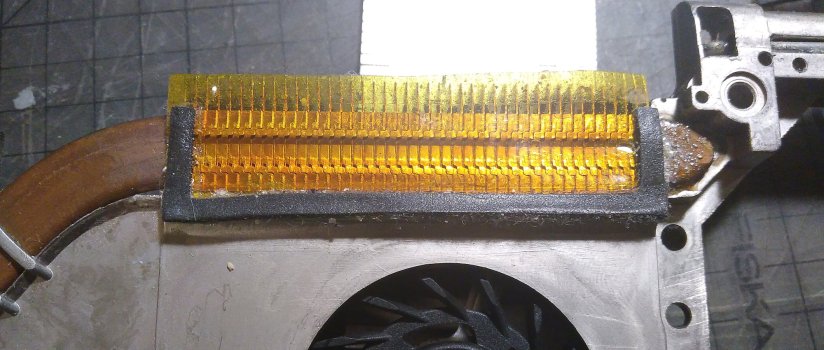
This presented a different problem: there was no way to remove the adhesive foam “U” piece from the kapton tape without ruining it.
Keeping the foam was important; but the kapton tape needed to go.
I contemplated simply using a razor blade to cut away all but the portion of the kapton tape located directly beneath the foam. This probably would have worked OK. I have, however a sheet of almost identical black-grey foam lying about for adding in fresh light seals for film camera loading doors (because I am a nerd, ok?).
So I made a pattern and then cut out two U-shaped pieces from that foam sheet to mimic the original two:
Because the new foam is also adhesive-backed, I affixed these to the copper grilles directly, like so:
Once these were in place on both sides, I went ahead and added the thermal pads to the full length of the heat pipes, along with dabs of thermal paste on the contact points, and then I reassembled everything:

Lastly, because the other lubrication I used on these fans a year or so ago didn’t hold up as long as I’d hoped, I thoroughly cleaned out the spindles and receptacles for each fan and added the same lubrication oil I’ve been using across all my fans — one designed for brushless fans and intended to work in settings where there’s a lot of long-term, high-rate motion.
RESULTS
As expected, making the passive cooling more robust along the entirety of heat pipe assembly made a
significant difference.
Before, an idling system (running 10.5.8, and having GyazMail, MinDisc, Terminal, Coconut Battery), in a room averaging 22–25°C ambient, had the
CPU Bottom and
CPU/Intrepid Bottom hovering around 48–49°C and occasionally 50–51°C — whilst the display was running (i.e., not on stand-by), with both of the fans spinning in the low-to-mid ranges of ~2300-4000, to maintain a G4FanControl-set target of 48:48:48.
Since then, however, the temperatures have plummeted.
Unless I’m running load-intensive tasks (like a browser or a
macports upgrade outdated command), I’m regularly, if not always, waking the display to find idling temperatures
as low as 38°C — with average temps for both sensors averaging between 39°C and 42°C. (!!!)
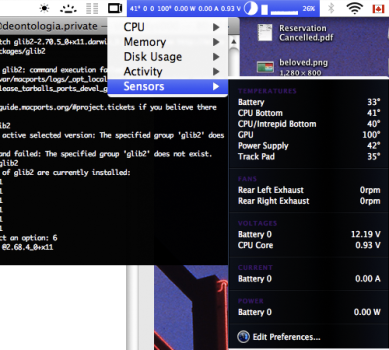
When the display is running, those temps can bump up slightly to 44°C, but rarely much higher.

Even at the higher end of these idling temps, the fans simply stay off. I am, frankly, unaccustomed to experiencing that with this particular A1139.
As shared on the previous post, when trying to push the processor to sustained loads of 100 per cent over time, I’ve been unable to push the
CPU Bottom sensor higher than 52°C or the
CPU/Intrepid Bottom sensor beyond 46°. Under these conditions, I can’t seem to reach 53° or higher — which is a far cry from past years when using the laptop, on my lap, and under a lot of load, could get those sensors pushing into the high 60s range.
I have been able to repeat these tests several days apart with the same conditions, and I have come up with the same results. Each time, I’ve been unable to get the fans to ramp up to their 7000rpm-designed limits. In fact, I haven’t been able to get either of them up to 6000rpm:
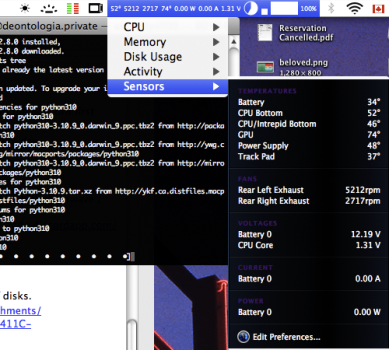
I will need to wait until summertime to determine whether higher ambient room temps (i.e., more along the 26–30°C range) can push those fans to their designed limits.
Waiting a couple of weeks to write up this post also permitted an opportunity to check whether these figures were flukes or indicative of a longer trend. I can say definitively that the results have remained consistent throughout.
CONCLUSION
As noted
after disassembling my A1261 a second time, just a couple of weeks after the first, I was so thoroughly blown away by the difference in temperatures (after applying thermal pads to the entire heat pipe assembly for the A1139), that I disassembled the A1261 to finish what I should have done the first time. I found that, while the added thermal pads may have taken the A1261 down another degree, it still resulted in a net improvement.
Unlike the A1138, the heat pipe assembly of the A1139 lacks pre-made holes for increasing the surface area for the heat-dissipating plate around the heat pipe assembly. I briefly considered where up to three holes in the A1139
could be drilled through, but decidedly promptly this was more effort than I felt was worth it. Plus, I lack access to the proper drilling equipment (i.e., a drill press) to do something like that in a clean, precise manner.
It’s kind of a bummer to only come to realize this thermal pad cooling method could have been used from the outset, back when I used the A1139 as a daily driver. But it’s still worth knowing, as cooler temperatures overall can facilitate a longer life for components (which are only getting more difficult to find with time). If I had a working A1104 PowerBook (the final 12-inch), I’d be trying out a similar passive cooling plan to keep its one fan from doing all the work in such a cramped space.
FINAL NOTES
At some point, I plan to use the remainder of these thermal pad sheets I bought for cheap on my A1047 Power Mac G5 — with especial care around the U3/backside heat sink for the memory controller (as that’s been a thorn in that system’s side for years).
When I bought the thermal pad sheets, I also bought a sheet of copper (0.3mm thickness — still plenty thick). I wasn’t sure I’d need it for the laptops, but I felt it better safe than sorry to have on hand. For something like the more complex heat sink on the G5, I plan to use both thermal pad and copper plates to help move heat to the G5 case directly, rather than just let channelled fan air do all the cooling work (which clearly hasn’t been enough, despite applying new thermal paste two years ago). It’ll be the last time I open that case for this kind of work, since I’m sort of at the end of my plans for what to do with it.
As always, thank you for reading through this long post!

